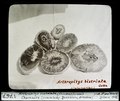Arthropitys
Extinct genus of ferns From Wikipedia, the free encyclopedia
Arthropitys is an extinct genus of calamitacean equisetale.[3] The petrified fossils of Arthropitys bistriata, the type species, can be found in the Leukersdorf Formation, Chemnitz petrified forest, Chemnitz, Germany.[4] The genus existed from the Carboniferous (Bashkirian)[5] until the Early Triassic (Olenekian).[6]
| Arthropitys | |
|---|---|
 | |
| A. bistriata fossils from Chemnitz in 1964 | |
| Scientific classification | |
| Kingdom: | Plantae |
| Clade: | Tracheophytes |
| Division: | Polypodiophyta |
| Class: | Polypodiopsida |
| Subclass: | Equisetidae |
| Order: | Equisetales |
| Family: | †Calamitaceae |
| Genus: | †Arthropitys Frenzel, 1751 |
| Species | |
| |
History
Summarize
Perspective
The first remains of Arthropitys were discovered in the early 16th century and were described by Georgius Agricola (1494–1555) in 1546.
In the mid-18th century, gemstone prospector David Frenzel (1691–1772) found numerous examples of this wood in the hills in and around Chemnitz.
One of Frenzel's 1751 finds is one of the few petrified wood specimens still possessing its roots. Later a collector, the Hilbersdorf contractor Güldner, bequeathed some of the petrified logs to King Albert Museum in Chemnitz. The first director of the Museum, Johann Traugott Sterzel, took over the investigation of the findings. The Sterzeleanum in the museum (the petrified forest display) is dedicated to him.[7]
The genus Arthropitys was named and described by Frenzel (1751) and the type species A. bistriata was named by Cotta (1864).[8] The type locality for A. bistrata and A. sp. is the Chemnitz petrified forest.
From April 4, 2008, to Fall 2011, an excavation in Hilbersdorf was held to find and research more trunks. Their researchers discovered, amongst others, Arthropitys bistriata. Many more plants and animals from this excavation are still being used for ongoing research.[3]
A. deltoides was named by Cichan and Taylor (1983) and was discovered in Kentucky.[9]
A. taoshuyuanensis was named by Chen et al. (2018) from specimens found in the Wutonggou Formation of China.[2]
A. buritiranensis was named by Neregato et al. (2021) from specimens found in the Motuca Formation of Brazil.[1]
Distribution
Specimens have also been discovered in Belgium,[10] Brazil,[1] China,[2] Germany,[3][10] Italy, the Netherlands,[10] Russia,[6] Spain,[10] the UK[10] and the US[5] (Illinois,[11][5] Indiana,[12] Kentucky[5] and Ohio[5]).
Classification
Rößler, Feng & Noll (2012) classified Arthropitys within Calamitaceae.[3]
Gallery
- Two Arthropitys .sp fossils discovered in Italy
- Fossils from the petrified forest of Chemnitz in which Arthrophitys .sp is common. Located in Chemnitz occurrence on display in the courtyard of DASTietz and Museum of Natural History Chemnitz
References
Wikiwand - on
Seamless Wikipedia browsing. On steroids.



